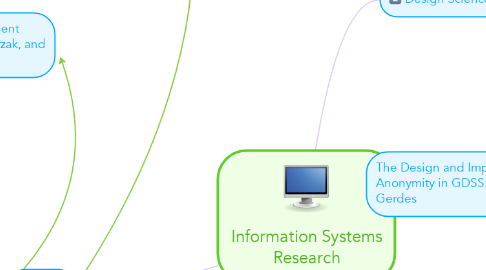
1. Cases
2. Behavioral Science Paradigm
2.1. its goal is
2.1.1. TRUTH
2.2. seeks
2.2.1. to develop & verify theories that explain or predict human or organizational behavior
3. A Workflow Language for Inter-Organizational Processes: Aalts and Kumar
3.1. Workflowprocesses
3.1.1. useful for business process
3.1.1.1. description
3.1.1.2. analysis
3.1.1.3. management
3.2. Inter-organizational processes
3.2.1. B2B communication
3.2.2. open, standard environment
3.2.3. no standard for workflow data
3.2.4. XML standard for data
3.3. proposed solutions
3.3.1. XRL
3.3.1.1. workflow language
3.3.1.2. petri-net based
3.3.1.3. verifiable
3.3.1.4. extensible
3.3.1.5. might not be complete
3.3.1.6. has 13 basic constructs
3.3.1.6.1. such as
3.3.2. XRL/flower
3.3.2.1. XRL implementation
3.3.2.2. Petri-net engine for execution
3.3.3. Wolfan
3.3.3.1. XRL/flower workflow verifier
4. Information Systems Design for Emergent Knowledge Processes: Markus, Majchrzak, and Gasser
4.1. Proposed Solution
4.1.1. TOP Modeler artifact
4.1.1.1. its knowledge base was formed from a synthesis of socio-technical systems theory & the empirical literature on organizational design knowledge
4.1.1.2. is implemented software system (instantiation)
4.1.1.2.1. composed by
4.1.1.2.2. includes
4.1.1.2.3. supports
4.2. Emergent Knowledge Processes (EKPs).
4.3. Problem is
4.3.1. Need to integrate organizational design and information system design with manufacturing operations
4.3.2. Effective methods for developing information systems that meet the information requirements of upper management remain elusive
4.3.2.1. Tested Methodologies
4.3.2.1.1. Waterfall
4.3.2.1.2. Protptyping
4.3.2.1.3. RAD
4.3.2.1.4. Extreme Programming
5. Design Science Paradigm
5.1. GUIDELINES
5.1.1. Design as an Artifact
5.1.2. Problem Relevance
5.1.3. Design Evaluation
5.1.4. Research Contributions
5.1.5. Research Rigor
5.1.6. Design as a Search Process
5.1.7. Communication of Research
5.2. Challenges
5.2.1. Inadequate theoretical base
5.2.2. Existing knowledge base is often insufficient for design purposes & must rely on intuition, experience & trial- and-error methods
5.2.3. Design-science research is perishable
5.2.4. Rigorous evaluation methods are extremely difficult to apply
5.3. is
5.3.1. Knowledge & understanding of a problem domain & its solution are
5.3.1.1. achieved
5.3.1.1.1. in the building & application of the designed artifact
5.4. seeks
5.4.1. Seeks to extend boundaries of human & organizational capabilities
5.4.1.1. by
5.4.1.1.1. creating new & innovative artifacts
5.5. its goal is
5.5.1. UTILITY
6. The Design and Implementation of Anonymity in GDSS: Gavish and Gerdes
6.1. Group Decision Support Systems
6.2. Anonymity
6.2.1. Can Encourage Free-Riding
6.2.2. Antisocial Behaviors
6.2.3. A desired feature by users
6.3. Purposed Solution
6.3.1. Messages are encrypted with a unique session key
6.3.2. Sender's header information is removed
6.3.3. Messages get re-encrypted upon re-transmission
6.3.4. Transmission order of messages gets randomized
6.3.5. Artificial messages are introduced to thwart traffic analysis

